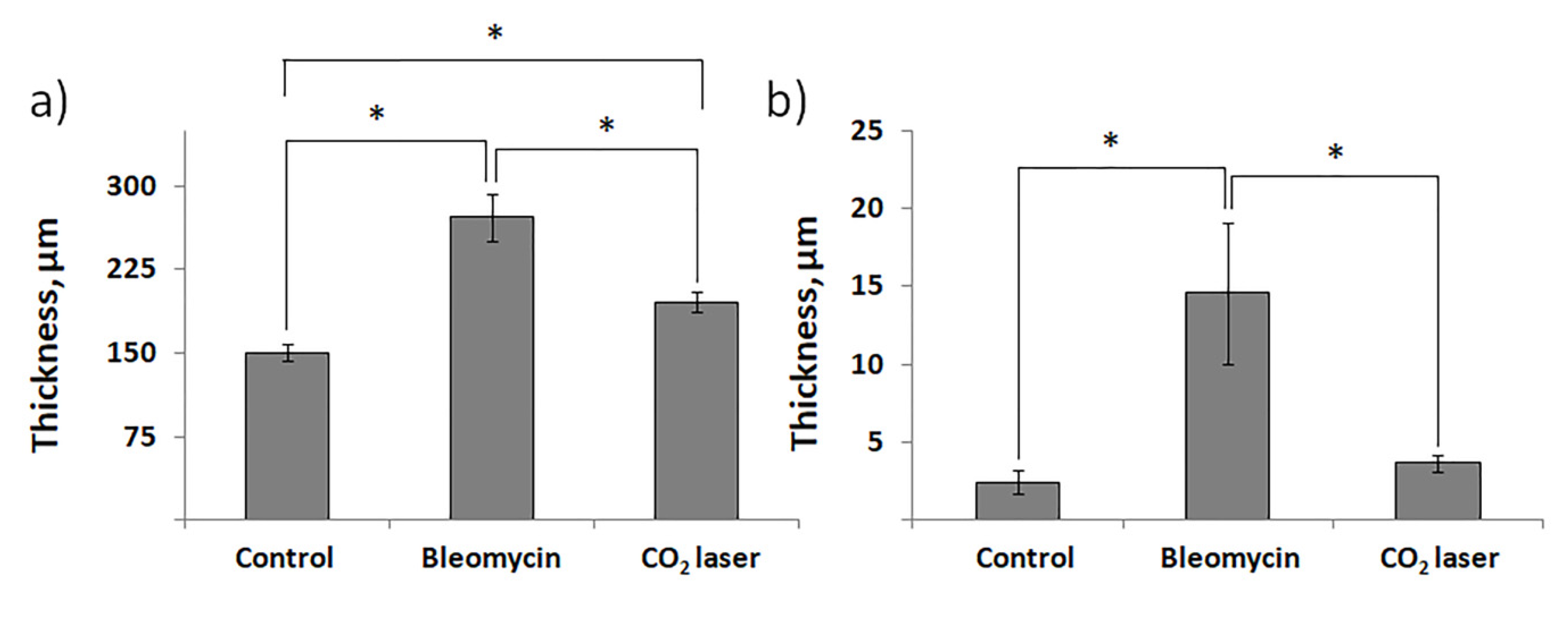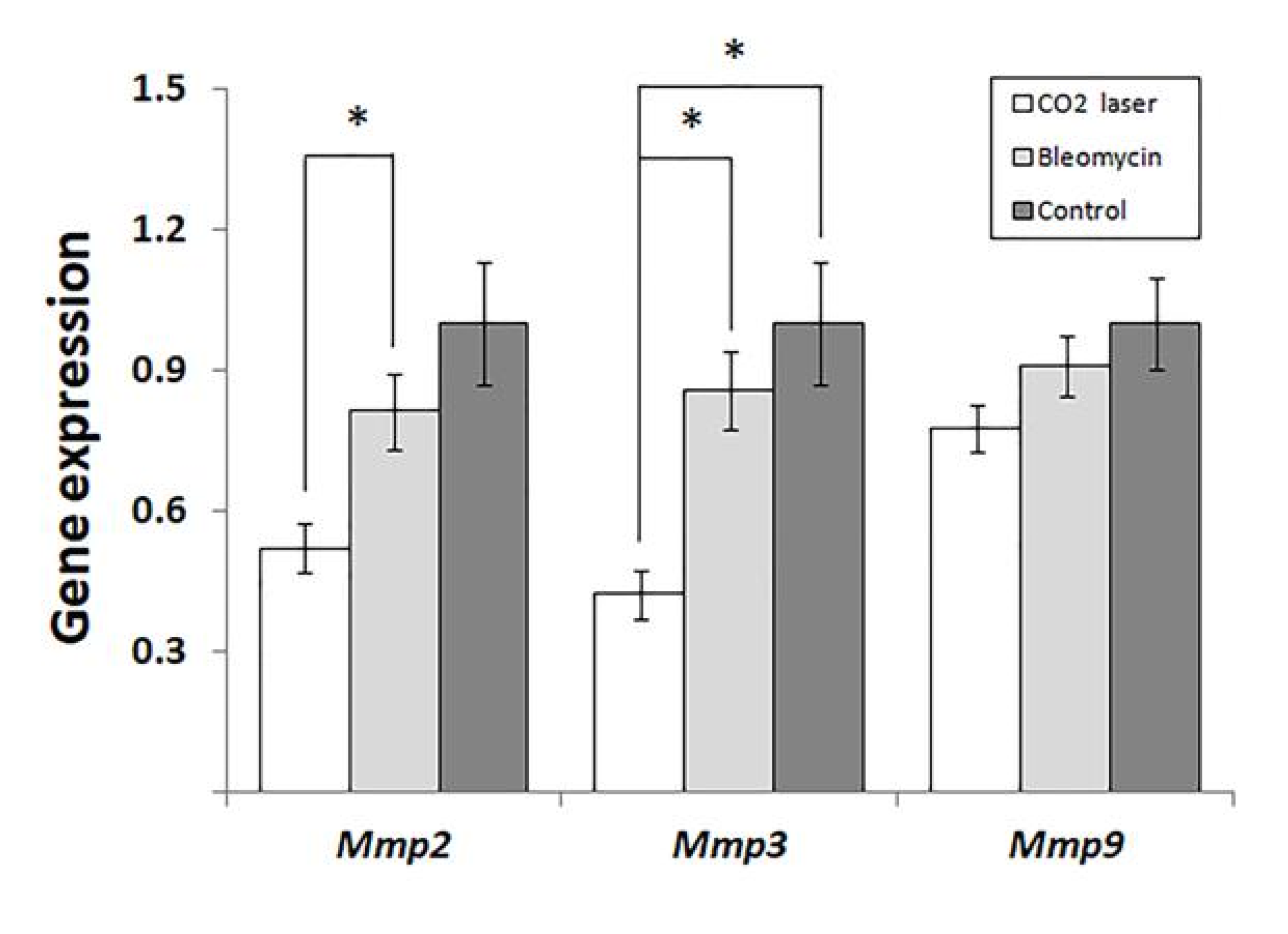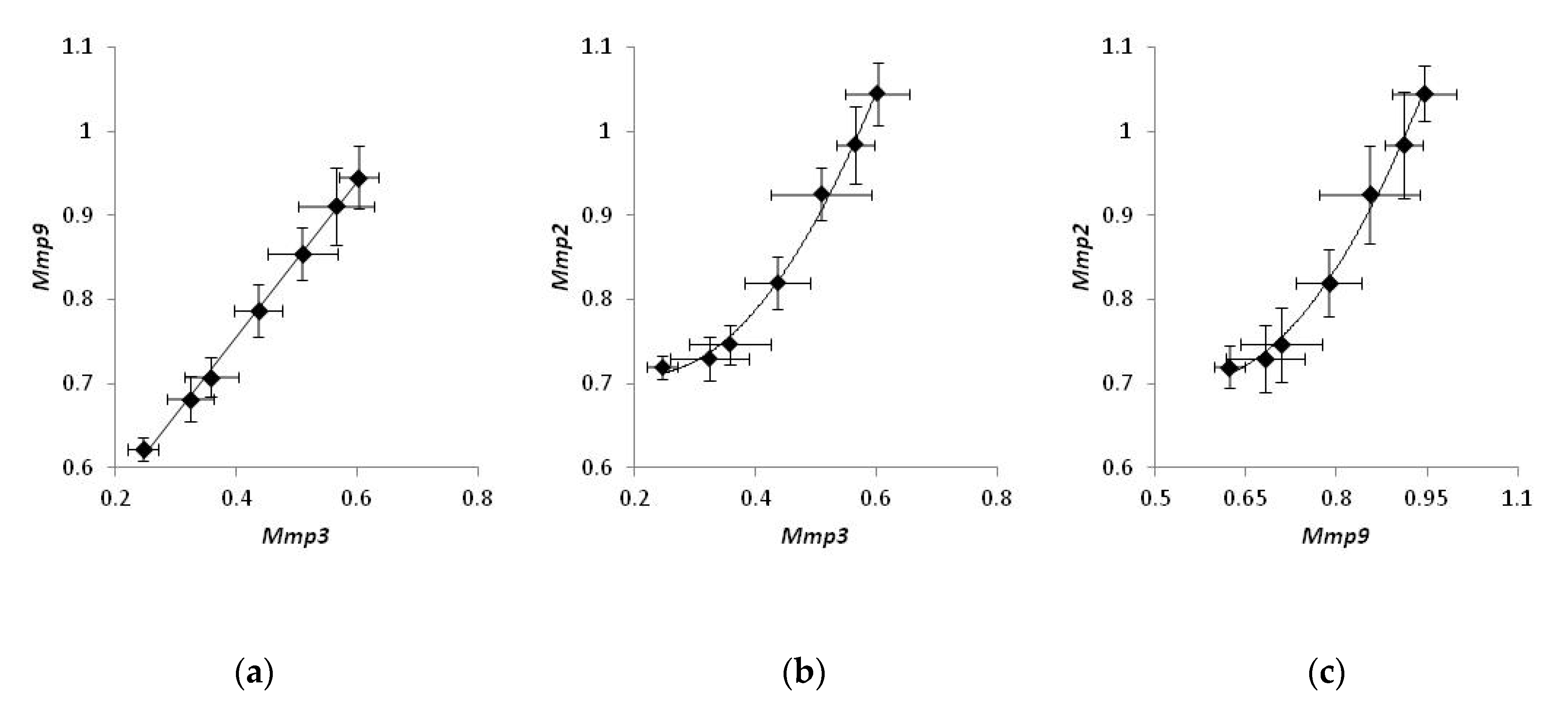Laser Therapy Changes the Expression of Matrix Metalloproteinases in Bleomycin-Induced Skin Fibrosis
Abstract
1. Introduction
2. Materials and Methods
2.1. Lab Animals
2.2. Purification of Total RNA
2.3. Real-Time PCR
2.4. Statistical Analysis
3. Results
3.1. Laser Therapy Normalizes the Histological Features of Skin Damaged with Bleomycin
3.2. Analysis of Gene Expression Revealed Significant Changes in the Expression of Matrix Metalloproteinases
4. Discussion
5. Conclusions
Author Contributions
Funding
Institutional Review Board Statement
Informed Consent Statement
Data Availability Statement
Acknowledgments
Conflicts of Interest
References
- Condorelli, A.G.; El Hachem, M.; Zambruno, G.; Nystrom, A.; Candi, E.; Castiglia, D. Notch-ing up knowledge on molecular mechanisms of skin fibrosis: Focus on the multifaceted Notch signalling pathway. J. Biomed. Sci. 2021, 28, 36. [Google Scholar] [CrossRef]
- Mezentsev, A.V.; Karapetyan, M.M.; Sobolev, V.V.; Zhukova, O.V.; Korsunskaya, I.M. Evaluation of biomarkers in the studies of keloid tissue after laser therapy. Med. Counc. 2022, 21, 80–85. [Google Scholar] [CrossRef]
- Griffin, M.F.; Desjardins-Park, H.E.; Mascharak, S.; Borrelli, M.R.; Longaker, M.T. Understanding the impact of fibroblast heterogeneity on skin fibrosis. Dis. Model. Mech. 2020, 13, dmm044164. [Google Scholar] [CrossRef] [PubMed]
- Do, N.; Eming, S. Skin fibrosis: Models and mechanisms. Curr. Res. Transl. Med. 2016, 64, 185–193. [Google Scholar] [CrossRef] [PubMed]
- Uitto, J.; Jimenez, S. Fibrotic skin diseases. Clinical presentations, etiologic considerations, and treatment options. Arch. Dermatol. 1990, 126, 661–664. [Google Scholar] [CrossRef] [PubMed]
- Rossi, A.M.; Hibler, B.P.; Navarrete-Dechent, C.; Lacouture, M.E. Restorative oncodermatology: Diagnosis and management of dermatologic sequelae from cancer therapies. J. Am. Acad. Dermatol. 2021, 85, 693–707. [Google Scholar] [CrossRef] [PubMed]
- Qu, M.; Song, N.; Chai, G.; Wu, X.; Liu, W. Pathological niche environment transforms dermal stem cells to keloid stem cells: A hypothesis of keloid formation and development. Med. Hypotheses 2013, 81, 807–812. [Google Scholar] [CrossRef]
- Smith, G.P.; Chan, E.S.L. Molecular pathogenesis of skin fibrosis: Insight from animal models. Curr. Rheumatol. Rep. 2010, 12, 26–33. [Google Scholar] [CrossRef]
- Rius Rigau, A.; Luber, M.; Distler, J.H.W. Mouse Models of Skin Fibrosis. Methods Mol. Biol. 2021, 2299, 371–383. [Google Scholar] [CrossRef]
- Park, H.J.; Jeong, O.-Y.; Chun, S.H.; Cheon, Y.H.; Kim, M.; Kim, S.; Lee, S.-I. Butyrate Improves Skin/Lung Fibrosis and Intestinal Dysbiosis in Bleomycin-Induced Mouse Models. Int. J. Mol. Sci. 2021, 22, 2765. [Google Scholar] [CrossRef]
- Hecker, L.; Jagirdar, R.; Jin, T.; Thannickal, V.J. Reversible differentiation of myofibroblasts by MyoD. Exp. Cell Res. 2011, 317, 1914–1921. [Google Scholar] [CrossRef] [PubMed]
- Chu, H.; Wang, Y.; Wang, X.; Song, X.; Liu, H.; Li, X. Effects of transplanted adipose derived stem cells on the expressions of α-SMA and DCN in fibroblasts of hypertrophic scar tissues in rabbit ears. Exp. Ther. Med. 2018, 16, 1729–1734. [Google Scholar] [CrossRef] [PubMed]
- Schmitt, L.; Huth, S.; Amann, P.M.; Marquardt, Y.; Heise, R.; Fietkau, K.; Huth, L.; Steiner, T.; Hölzle, F.; Baron, J. Direct biological effects of fractional ultrapulsed CO2 laser irradiation on keratinocytes and fibroblasts in human organotypic full-thickness 3D skin models. Lasers Med. Sci. 2017, 33, 765–772. [Google Scholar] [CrossRef]
- Gertz, S.D.; Gavish, L.; Mintz, Y.; Beeri, R.; Rubinstein, C.; Gavish, L.Y.; Berlatzky, Y.; Appelbaum, L.; Gilon, D. Contradictory Effects of hypercholesterolemia and diabetes mellitus on the progression of abdominal aortic aneurysm. Am. J. Cardiol. 2015, 115, 399–401. [Google Scholar] [CrossRef] [PubMed]
- Leong, E.; Bezuhly, M.; Marshall, J.S. Distinct Metalloproteinase Expression and Functions in Systemic Sclerosis and Fibrosis: What We Know and the Potential for Intervention. Front. Physiol. 2021, 12, 727451. [Google Scholar] [CrossRef]
- Mogulevtseva, J.A.; Mezentsev, A.V.; Bruskin, S.A. The Role of Matrix Metalloproteinases in the Pathogenesis of Psoriasis. In A Closer Look at Metalloproteinases; Nova Science Publishers: Hauppauge, NY, USA, 2019; pp. 97–130. [Google Scholar]
- Ye, J.; Coulouris, G.; Zaretskaya, I.; Cutcutache, I.; Rozen, S.; Madden, T.L. Primer-BLAST: A tool to design target-specific primers for polymerase chain reaction. BMC Bioinform. 2012, 13, 134. [Google Scholar] [CrossRef]
- Livak, K.J.; Schmittgen, T.D. Analysis of relative gene expression data using real-time quantitative PCR and the 2−ΔΔCT Method. Methods 2001, 25, 402–408. [Google Scholar] [CrossRef]
- Arifin, W.N.; Zahiruddin, W.M. Sample Size Calculation in Animal Studies Using Resource Equation Approach. Malays. J. Med. Sci. 2017, 24, 101–105. [Google Scholar] [CrossRef]
- Rohani, M.G.; Parks, W.C. Matrix remodeling by MMPs during wound repair. Matrix Biol. 2015, 44–46, 113–121. [Google Scholar] [CrossRef]
- Xue, M.; Jackson, C.J. Extracellular matrix reorganization during wound healing and its impact on abnormal scarring. Adv. Wound Care. 2015, 4, 119–136. [Google Scholar] [CrossRef]
- Imaizumi, R.; Akasaka, Y.; Inomata, N.; Okada, E.; Ito, K.; Ishikawa, Y.; Maruyama, Y. Promoted activation of matrix metalloproteinase (MMP)-2 in keloid fibroblasts and increased expression of MMP-2 in collagen bundle regions: Implications for mechanisms of keloid progression. Histopathology 2009, 54, 722–730. [Google Scholar] [CrossRef] [PubMed]
- Matuszczak, E.; Weremijewicz, A.; Koper-Lenkiewicz, O.M.; Kamińska, J.; Hermanowicz, A.; Dębek, W.; Komarowska, M.; Tylicka, M. Effects of combined Pulsed Dye Laser and Fractional CO2 Laser treatment of burn scars and correlation with plasma levels of collagen type I, MMP-2 and TIMP-1. Burns 2021, 47, 1342–1351. [Google Scholar] [CrossRef]
- Lee, Y.I.; Kim, S.; Kim, J.; Kim, J.; Chung, K.B. Randomized controlled study for the anti-aging effect of human adipocyte-derived mesenchymal stem cell media combined with niacinamide after laser therapy. J. Cosmet. Dermatol. 2021, 20, 1774–1781. [Google Scholar] [CrossRef]
- Chung, J.; Kim, K.; Park, D.J.; Ji, Y.; Yoon, E.; Park, S. Early Treatment Effects of Nonablative Fractional Lasers (NAFL) on Hypertrophic Scars in an Animal Model. Lasers Surg. Med. 2021, 53, 537–548. [Google Scholar] [CrossRef] [PubMed]
- Issler-Fisher, A.C.; Waibel, J.S.; Donelan, M.B. Laser modulation of hypertrophic scars. Clin. Plast. Surg. 2017, 44, 756–766. [Google Scholar] [CrossRef] [PubMed]
- Laubach, H.-J.; Tannous, Z.; Anderson, R.R.; Manstein, D. Skin responses to fractional photothermolysis. Lasers Surg. Med. 2006, 38, 142–149. [Google Scholar] [CrossRef]
- Bauer, A.; Habior, A. Concentration of Serum Matrix Metalloproteinase-3 in Patients with Primary Biliary Cholangitis. Front. Immunol. 2022, 13, 885229. [Google Scholar] [CrossRef]
- Bassiouni, W.; Ali, M.A.M.; Schulz, R. Multifunctional intracellular matrix metalloproteinases: Implications in disease. FEBS J. 2021, 288, 7162–7182. [Google Scholar] [CrossRef]
- Bullard, K.M.; Mudgett, J.; Scheuenstuhl, H.; Hunt, T.K.; Banda, M.J. Stromelysin-1-deficient fibroblasts display impaired contractionin vitro. J. Surg. Res. 1999, 84, 31–34. [Google Scholar] [CrossRef]
- Amann, P.M.; Marquardt, Y.; Steiner, T.; Hölzle, F.; Skazik-Voogt, C.; Heise, R.; Baron, J.M. Effects of non-ablative fractional erbium glass laser treatment on gene regulation in human three-dimensional skin models. Lasers Med. Sci. 2016, 31, 397–404. [Google Scholar] [CrossRef]
- Glezeva, N.; Moran, B.; Collier, P.; Moravec, C.S.; Phelan, D.; Donnellan, E.; Russell-Hallinan, A.; O’Connor, D.P.; Gallagher, W.M.; Gallagher, J.; et al. Targeted DNA Methylation Profiling of Human Cardiac Tissue Reveals Novel Epigenetic Traits and Gene Deregulation Across Different Heart Failure Patient Subtypes. Circ. Heart Fail. 2019, 12, e005765. [Google Scholar] [CrossRef] [PubMed]
- Bergman, M.R.; Cheng, S.; Honbo, N.; Piacentini, L.; Karliner, J.S.; Lovett, D.H. A functional activating protein 1 (AP-1) site regulates matrix metalloproteinase 2 (MMP-2) transcription by cardiac cells through interactions with JunB-Fra1 and JunB-FosB heterodimers. Biochem. J. 2003, 369, 485–496. [Google Scholar] [CrossRef]
- Chandra, S.; Ehrlich, K.C.; Lacey, M.; Baribault, C.; Ehrlich, M. Epigenetics and expression of key genes associated with cardiac fibrosis: NLRP3, MMP2, MMP9, CCN2/CTGF and AGT. Epigenomics 2021, 13, 219–234. [Google Scholar] [CrossRef]
- Li, J.; Hsu, A.; Hua, Y.; Wang, G.; Cheng, L.; Ochiai, H.; Yamamoto, T.; Pertsinidis, A. Single-gene imaging links genome topology, promoter–enhancer communication and transcription control. Nat. Struct. Mol. Biol. 2020, 27, 1032–1040. [Google Scholar] [CrossRef] [PubMed]
- Shibata, Y.; Araki, H.; Oshitani, T.; Imaoka, A.; Matsui, M.; Miyazawa, K.; Abiko, Y. Effects of linear polarized infrared light irradiation on the transcriptional regulation of IL-8 expression in IL-1β-stimulated human rheumatoid synoviocytes involves phosphorylation of the NF-κB RelA subunit. J. Photochem. Photobiol. B: Biol. 2009, 94, 164–170. [Google Scholar] [CrossRef] [PubMed]
- Lupiáñez, D.G.; Kraft, K.; Heinrich, V.; Krawitz, P.; Brancati, F.; Klopocki, E.; Horn, D.; Kayserili, H.; Opitz, J.M.; Laxova, R.; et al. Disruptions of topological chromatin domains cause pathogenic rewiring of gene-enhancer interactions. Cell 2015, 161, 1012–1025. [Google Scholar] [CrossRef]
- Supp, D.M. Animal Models for Studies of Keloid Scarring. Adv. Wound Care 2019, 8, 77–89. [Google Scholar] [CrossRef]
- Wang, W.-B.; Li, H.-P.; Yan, J.; Zhuang, F.; Bao, M.; Liu, J.-T.; Qi, Y.-X.; Han, Y. CTGF regulates cyclic stretch-induced vascular smooth muscle cell proliferation via microRNA-19b-3p. Exp. Cell Res. 2019, 376, 77–85. [Google Scholar] [CrossRef]




| Gene | Reference Sequence | Primer Name | Primer Sequence | Product Size, bp |
|---|---|---|---|---|
| MMP2 | NM_008610.3 | MMP2 forward | CCCTGATAACCTGGATGCCG | 214 |
| MMP2 reverse | AGGCTGCTTCACATCCTTCAC | |||
| MMP3 | NM_010809.2 | MMP3 forward | CATGAACTTGGCCACTCCCT | 179 |
| MMP3 reverse | GTGGGTACCACGAGGACATC | |||
| MMP9 | NM_013599.5 | MMP9 forward | TGGTCTTCCCCAAAGACCTG | 216 |
| MMP9 reverse | CACAGCGTGGTGTTCGAATG | |||
| 18S RNA | NR_003278.3 | 18S RNA forward | GCAATTATTCCCCATGAACG | 123 |
| 18S RNA reverse | TTGGATGGTTTAGTGAGGCC |
Disclaimer/Publisher’s Note: The statements, opinions and data contained in all publications are solely those of the individual author(s) and contributor(s) and not of MDPI and/or the editor(s). MDPI and/or the editor(s) disclaim responsibility for any injury to people or property resulting from any ideas, methods, instructions or products referred to in the content. |
© 2023 by the authors. Licensee MDPI, Basel, Switzerland. This article is an open access article distributed under the terms and conditions of the Creative Commons Attribution (CC BY) license (https://creativecommons.org/licenses/by/4.0/).
Share and Cite
Soboleva, A.G.; Sobolev, V.V.; Karapetyan, M.M.; Mezentsev, A.; Rud’ko, O.I.; Davydova, E.D.; Mogulevtseva, J.A.; Zhukova, O.V.; Korsunskaya, I.M. Laser Therapy Changes the Expression of Matrix Metalloproteinases in Bleomycin-Induced Skin Fibrosis. Life 2023, 13, 810. https://doi.org/10.3390/life13030810
Soboleva AG, Sobolev VV, Karapetyan MM, Mezentsev A, Rud’ko OI, Davydova ED, Mogulevtseva JA, Zhukova OV, Korsunskaya IM. Laser Therapy Changes the Expression of Matrix Metalloproteinases in Bleomycin-Induced Skin Fibrosis. Life. 2023; 13(3):810. https://doi.org/10.3390/life13030810
Chicago/Turabian StyleSoboleva, Anna G., Vladimir V. Sobolev, Mari M. Karapetyan, Alexandre Mezentsev, Olga I. Rud’ko, Evgenia D. Davydova, Julia A. Mogulevtseva, Olga V. Zhukova, and Irina M. Korsunskaya. 2023. "Laser Therapy Changes the Expression of Matrix Metalloproteinases in Bleomycin-Induced Skin Fibrosis" Life 13, no. 3: 810. https://doi.org/10.3390/life13030810
APA StyleSoboleva, A. G., Sobolev, V. V., Karapetyan, M. M., Mezentsev, A., Rud’ko, O. I., Davydova, E. D., Mogulevtseva, J. A., Zhukova, O. V., & Korsunskaya, I. M. (2023). Laser Therapy Changes the Expression of Matrix Metalloproteinases in Bleomycin-Induced Skin Fibrosis. Life, 13(3), 810. https://doi.org/10.3390/life13030810






